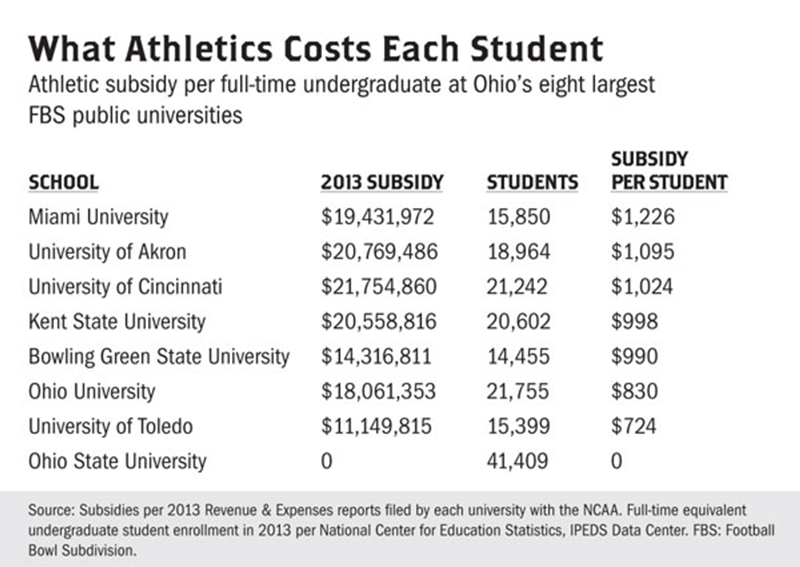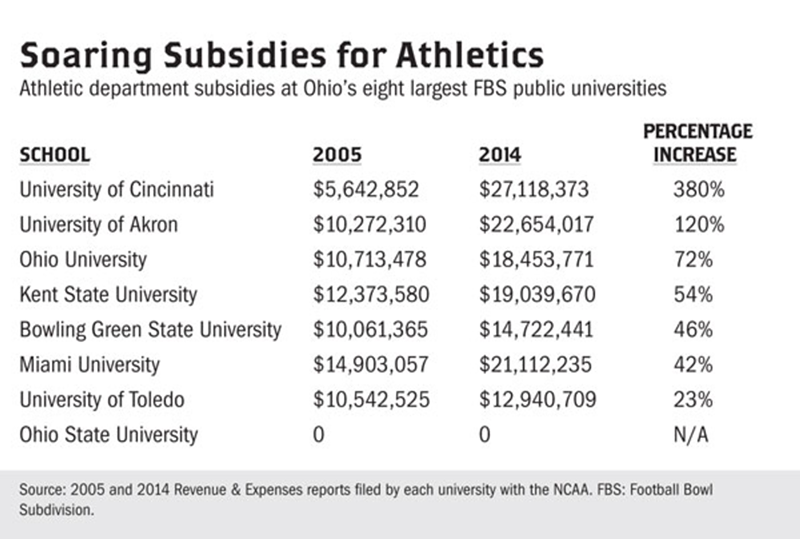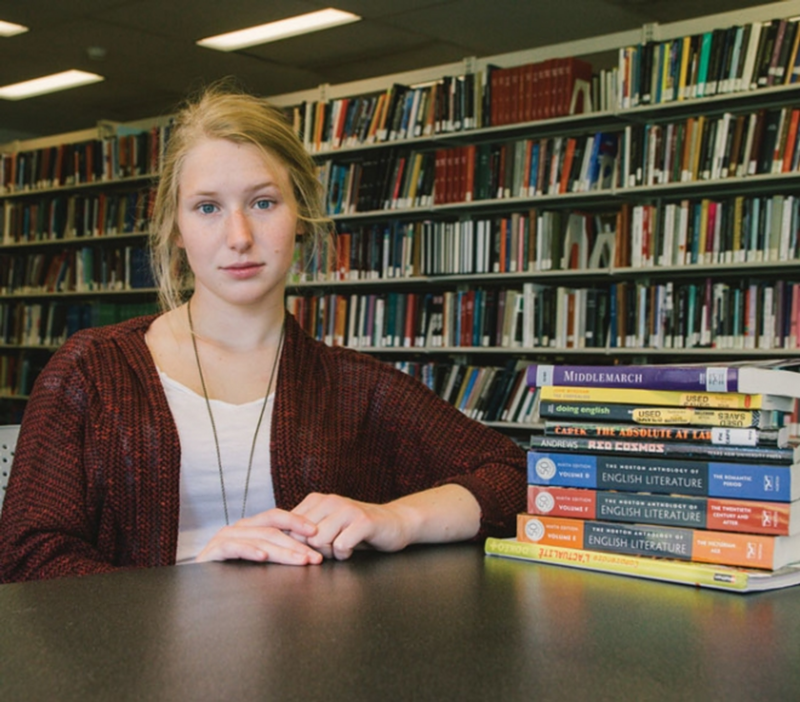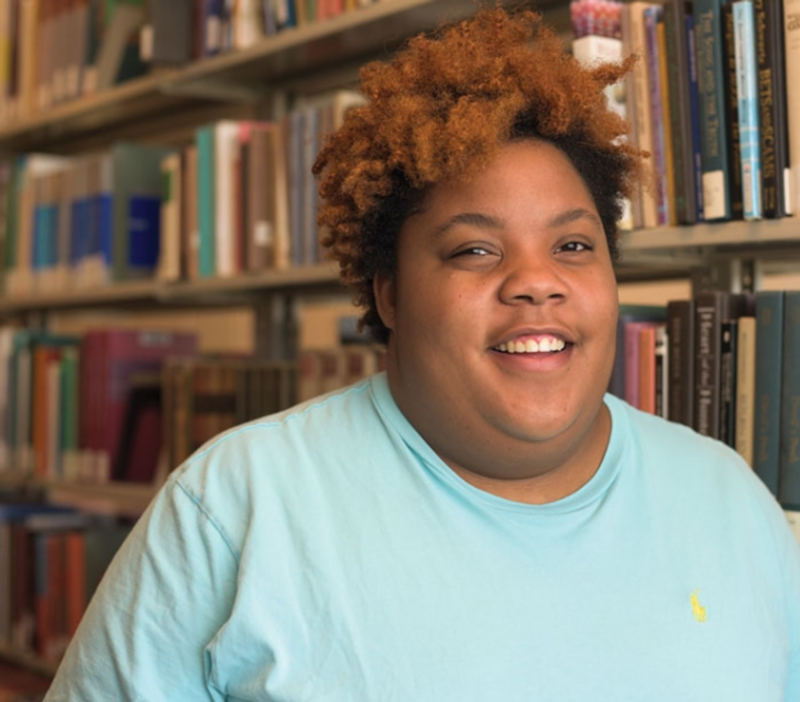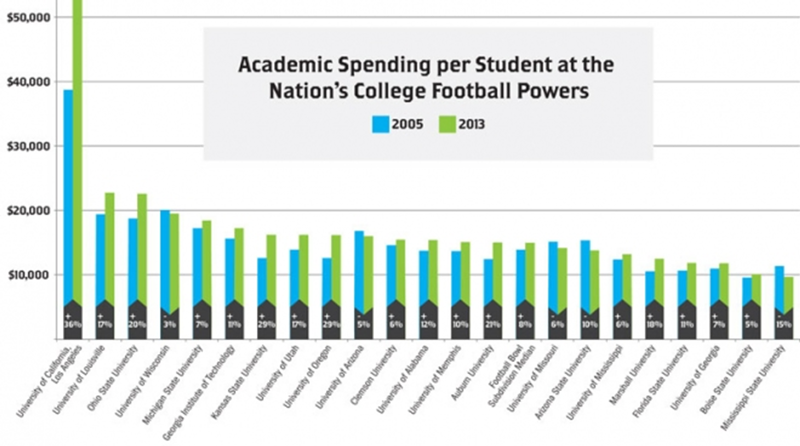
This story was written and reported by an investigative reporting class at the University of Cincinnati. Reporting by Morgan Batanian, Katie Coburn, Fernanda Crescente, Taylor Jackson, Tyler Kuhnash and Camri Nelson. Research contributed by Taylor Hayden, Talis Linauts, Kayleigh Murch, Matt Nichols, Malia Pitts and Lauren Smith.
Kevin Leugers pays the University of Cincinnati to provide him with a quality education.
The second-year student majoring in marketing and philosophy had no idea officials had quietly funneled tens of millions of dollars from students to the athletic department in recent years to cover the difference between revenue and expenses.
“It seems to be a corruption of education, in all honesty,” says Leugers, a University Honors Program student and Kolodzik Business Scholar. “Athletics is being given priority over education, over the professors, over the students. I just think that’s wrong.”
In 2013, UC officials provided the athletic department with a $21.75 million subsidy, records show, using student fees and money from the school’s general fund, which is primarily funded by tuition. The total subsidy amounts to $1,024 out of the pocket of every full-time undergraduate student on UC’s main campus. The four-year price tag costs each student more than $4,000.
The money represents 20 percent of the $20,000 Leugers plans to borrow to finance his education.
The athletic department’s four-year hidden tax may very well exceed $4,000 per student. In 2014 the subsidy rose to more than $27 million, a 25-percent increase.
Since 2007, University of Cincinnati trustees and administrators have used more than $127 million in student fees and general fund money to subsidize deficits in the athletic department, according to UC’s NCAA Revenue & Expense reports.
Thomas Humes, UC’s board chair and a trustee since 2007, says the $127 million sports subsidy is a necessity to keep pace with other programs.
“I think it is a requirement,” says Humes, a developer and former UC administrator.
Humes says sports are “a good investment for the university as a whole” and that the board decided every dollar given to the athletic department was money well spent.
“There has been a decision that whatever that investment number is that it is a positive investment for the university,” he says. “I don’t view it as a concern.”
The investment certainly brought a high return in 2014 to some UC coaches, particularly compared to the university’s 334 student-athletes. The university provided the students with $5.99 million in scholarship aid, less than 11 percent of the $55.4 million in athletic expenditures, according to UC’s NCAA report.
That same year, UC paid a dozen coaches on the football and men’s basketball teams more than $10.5 million, 19 percent of total spending. At the top was Tommy Tuberville, UC’s head football coach, who received $3.8 million.
The situation at the University of Cincinnati is not unique. A CityBeat investigation of the eight largest public universities in Ohio in the Football Bowl Subdivision found that with one exception, college administrators and trustees impose hidden fees and invisible taxes on thousands of working-class students who pay tens of millions of dollars in subsidies to keep money-losing athletic departments afloat.
“It’s Robin Hood in reverse,” says Jeff Smith, a college sports subsidies expert who teaches management at the University of South Carolina Upstate. “These schools are imposing a regressive tax on those students least able to afford it. If I were a student, I would be screaming about this.”
Many of these same schools are cutting faculty jobs and slashing academic spending. Between 2005 and 2013, academic spending per full-time undergraduate student at UC, adjusted for inflation, dropped 24 percent, according to the Knight Commission on Intercollegiate Athletics, a national group of current and former college presidents seeking to reform college athletics using research studies and, more recently, online databases.
In other words, over the past decade UC leaders have used student fees and tuition to cover a nearly five-fold increase in the athletic department’s annual deficit while cutting academic spending per student by almost 25 percent.
CityBeat asked UC President Santa Ono, whose Twitter hashtag is “HottestCollegeinAmerica,” for an interview to discuss these findings. Ono's official biography says he “has gained a reputation as a chief executive who is accessible and responsive to the university’s wide range of constituents.” He declined to be interviewed.
Like UC, most Ohio public universities have an open checkbook for sports and a tightfisted approach to academic spending. For example:
• Over the past decade, annual sports spending — and subsidies — at the University of Akron more than doubled. During these years, students paid more than $130 million in athletic fees, records show. In 2014, Akron Athletic Director Tom Wistrcill used $13,000 to purchase bobble-head likenesses of then-President Luis Proenza to express his appreciation to the president for having “ensured that the university provides our student athletes and coaches with first class facilities.” Meanwhile, trustees have raised tuition and slashed academic spending, including the elimination of more than 100 jobs. Wistrcill told CityBeat the university is giving students what they want. “We get institutional support both from the students and from the campus to make our budget work, and we feel like we provide a great part of the student experience to the non-athletes,” he said.
• Miami University is the most expensive four-year public college in the nation, according to a 2014 U.S. Department of Education report. One reason: sports subsidies. In 2013, each full-time undergraduate student provided the athletic department with $1,266, the highest subsidy among Ohio’s eight largest FBS public schools. That same year, the university’s Board of Trustees and President David Hodge were so pleased with the athletic department’s performance they gave Athletic Director David Sayler a five-year extension.
Sayler declined comment for this story. While annual athletic spending increased 44 percent over the past decade, the president and trustees made $50 million in budget cuts outside athletics. The Knight Commission database shows that between 2005 and 2013, inflation-adjusted academic spending — including faculty salaries, department research and student services — for each full-time undergraduate dropped 6 percent at Miami University, a school that advertises itself as “Ohio’s Public Ivy.” Alexa Brown, a third-year art education student, says officials should back up their slogan with action: “If we’re trying to be Ivy League, we should focus more on academics rather than trying to be like the Big Ten.”
• At Bowling Green State University, each full-time undergraduate student paid almost $1,000 to subsidize sports in 2013. Since then, the BGSU Board of Trustees has cut 130 faculty jobs, according to David Jackson, an associate professor of political science and president of the BGSU Faculty Association. The trustees did significantly raise funding in one area ostensibly related to academics: They increased President Mary Ellen Mazey’s compensation 40 percent to $600,149, according to The Chronicle of Higher Education.
“University administrators tend to take care of themselves and make sure that they are very well paid,” Jackson says.
Kevin Leugers, second-year marketing and philosophy student at the University of Cincinnati
/ Photo: Jesse Fox
Students at each of these schools told CityBeat they were unaware they were subsidizing the athletic department.
“I don’t think that’s fair,” says Ellyn DeLisle, a second-year fashion merchandising student at the University of Akron. “I don’t know how else they can get funds, but I feel like there has to be a way other than charging students and not telling them.”
David Ridpath, an associate professor of sports administration at Ohio University, is familiar with DeLisle’s plight. After spending years studying athletic subsidies at public universities throughout Ohio, he found most school officials try to hide the diversion of money.
“They don’t want people to see it,” Ridpath says. “Universities don’t respond until they get embarrassed.”
[Follow the money: Examine your school's academic spending over time and compare with other schools by using the Knight Commission on Intercollegiate Athletics database here.]
The exception to this dismal picture can be found at Ohio State University. Its athletic department generates astonishing profits while the administration continues to ratchet up academic spending.
Some students are beginning to take notice.
Michael Fyffe attended Bowling Green State University in 2013-14. He paid approximately $1,000 in fees and general fund money to subsidize the athletic department. As for his education, BGSU’s academic spending per full-time undergraduate student was 13 percent less in 2013 than in 2005, according to the Knight Commission database.
In 2014, Fyffe enrolled at Ohio State. The second-year structural engineering student pays no athletic subsidy and attends a university where academic spending for each full-time undergraduate rose 20 percent since 2005.
“I definitely notice the difference,” Fyffe says. “Here at OSU, the athletic department is always giving back to the school and students. It really feels like the academic institution and athletics work cooperatively for the benefit of us, the students.”
The same cannot be said for the majority of Ohio’s other public universities. Just ask William Rich, an associate professor at the University of Akron’s School of Law and chair of UA’s Faculty Senate.
At a Faculty Senate meeting last year, Rich said the university’s 2015 spending priorities were “backwards.” He said trustees, having cut the College of Arts & Sciences’ budget 14 percent over the previous two years, planned an additional 6.7 percent reduction in 2015.
Rich warned that slashing spending by 20 percent in Arts & Sciences — “the heart of this university” — and other academic cuts would undermine instruction, lessen enrollment, diminish student success and reduce revenue. “Continuation of this trend can only result in a fiscal death spiral for the university,” he said.
The effects may already have begun.
The University of Akron reported full-time undergraduate enrollment of 17,645 in 2010. NCAA records for 2014 show it was 13,904, a 21-percent drop.
UC Doubles Down on Athletics
On January 4, 2010, a University of Cincinnati task force issued a report regarding the future of UC sports.
The report said the UC Athletic Department had an “accumulated deficit” of $24 million — largely because of the $105 million Varsity Village sports complex — and a “yearly deficit” of $3.5 million (the actual deficit was $13.4 million, according to UC’s 2010 NCAA report).
Why the red ink?
“A historical lack of interest in UC sports,” the report said.
The task force surveyed students, faculty, staff and alumni regarding athletics and nine other areas of campus life. More than 700 persons responded.
They ranked academic programs first, faculty second and intercollegiate athletics last.
The 19-member task force promptly recommended UC pour more money into subsidizing athletics, including raising tuition in order to collect more fees from students. This was not surprising given the task force’s makeup, which included nine high-ranking administrators, two trustees, a dean and three athletic department representatives.
Then-President Gregory Williams endorsed the recommendations on Jan. 12. “We have an outstanding program that’s substantially underfunded,” he explained.
Two days later, USA Today reported sobering news: Between 2005 and 2008 athletic subsidies grew faster at the University of Cincinnati than at any of the other 98 FBS public schools.
Faculty Senate members tried to stop the runaway sports spending. They unanimously approved a resolution in March that said UC “should NOT allocate more general fund money to subsidize the athletic department” and should negotiate to use Paul Brown Stadium for home football games instead of expanding Nippert Stadium.
Administrators and trustees ignored the recommendations. The result: a flood of red ink.
NCAA records show the athletic department subsidy rose from $13.4 million in 2010 to $27.1 million in 2014. Between 2010 and 2014, UC officials quietly diverted more than $93 million in student fees and general fund money, primarily tuition, to cover athletic department deficits.
Marla Hall, who chaired the Faculty Senate in 2010, told CityBeat the faculty’s voice was drowned out by more powerful ones.
“We are just one voice,” says Hall, an associate professor of psychology and a current Faculty Senate member. “When it comes to athletics, it seems that on that specific topic other voices and other concerns seem to be louder. They dominate the decision-making.”
CityBeat interviewed more than a dozen UC students. Most said they were shocked at being forced to pay the soaring sports subsidies.
“I think they are lying to us, and I think that’s unfair,” says Caitlin Saia, a second-year English literature and French student who works part-time as a children’s tutor at a library. “I didn’t come to UC for sports. I came for an education.”
Jalilisha Dixon is a third-year English literature student and a Pell Grant recipient, the federal program designed to help low-income students. She was one of several students who believe UC should not use student dollars to subsidize its athletic department.
“That’s the university’s responsibility,” Dixon says. “If more students knew about this, there would be fewer students attending this university.”
In 2012, trustees named Santa Ono as president. The following year, the UC Board of Trustees approved an $86 million plan to renovate Nippert Stadium. Officials vowed no general fund money would be used, the same promise they made for Varsity Village.
President Ono has said on the record that students come to UC to experience intercollegiate athletics.
Sports also binds them together once they arrive, says Humes, the trustees’ board chair.
“It’s something everybody can identify with,” Humes told CityBeat. “It drives emotions and excitement and spirit and attitude. It’s our common rallying point.”
Not one student told CityBeat sports brought them to UC.
Caitlin Saia, second-year English literature and French student at the University of Cincinnati
/ Photo: Jesse Fox
“I did not choose UC for its sports programs,” says Austin Hall, a first-year actuarial sciences and statistics student. “Students aren’t paying for sports. They’re paying to get an education.”
According to Humes and Athletic Director Mike Bohn, a successful athletic program serves as an attractive “front porch” for UC, significantly boosting applications from prospective students and contributions from donors.
“It’s an investment, and it’s an investment in the enterprise on campus,” Bohn says. “It’s a strategic investment with a high return.”
Several UC students said this is not the case. A wealth of scholarly studies support their view.
In a 2004 study titled “Challenging the Myth,” Robert Frank examined more than 30 academic studies and found the benefits of a successful sports program “are almost surely very small.”
Frank, an economics professor at Cornell University, concluded, “The empirical literature provides not a shred of evidence to suggest that an across-the-board cutback in spending on athletics would reduce either donations by alumni or applications by prospective students.”
When the UC Task Force surveyed students, faculty, staff and alumni in 2009, there was unanimous agreement on one point: “All groups commented that UC shouldn’t fund athletics at the expense of academics.”
Instead, sports spending soared, and academic spending nosedived.
In 2005, UC’s inflation-adjusted academic spending was $20,249 for each full-time undergraduate, more than any other Ohio public university and 46 percent above the median for all FBS public universities, according to the Knight Commission database.
Over the next eight years, UC’s academic spending per student dropped 24 percent while the median spending for all FBS public schools rose eight percent. By 2013, UC’s academic spending for each full-time undergraduate had dwindled to $15,456, less than Ohio State, Miami University and the University of Toledo, and just three percent above the FBS median.
The change has not escaped the attention of students like Dixon.
“Students are the main reason the university is here,” she says. “But UC is not putting as much emphasis on a quality education as other schools.”
Jalilisha Dixon, third-year English literature student at the University of Cincinnati / Photo: Jesse Fox
The Delta Cost Project, which specializes in analyzing university spending, produced the Knight Commission database using statistics reported by universities to the U.S. Department of Education.
Humes says he is not familiar with the database but that he believes its findings are wrong.
“I don’t know if that’s true,” he says. “I think our support for the colleges and the academics of the university are extremely strong.”
Knight Commission Executive Director Amy Perko says commission members decided to put a database of academic and athletic spending online after universities for decades ignored its reports calling for reduced sports spending and more transparency.
“There were no actions taken on those recommendations, and that’s the reason the commission produced this database,” she told CityBeat.
Logan Shannon, a second-year criminal justice student, says UC spending shows the university has its priorities backward. “It perfectly exemplifies the belief that athletics are superior to academics,” Shannon says.
Gabriele Tisch, a first-year mechanical engineering student, says UC officials are sending a clear message: “They really don’t care about the students.”
Bohn says his department hopes to decrease its deficit by increasing revenue.
“Our current strategy on our budget is to continue to generate as much revenue as we can externally,” he said during an interview in his eighth-floor office of the Richard E. Linder Center, the centerpiece of the Varsity Village project and home to UC’s sports programs.
To implement the strategy, UC officials continue to pour more money into athletics. In 2013, the university began an $86 million renovation of Nippert Stadium and recently hired an architectural firm to develop plans for a $70 million renovation of Fifth Third Arena.
Some students told CityBeat they were aware they pay an athletic fee. However, not one knew the exact amount nor did they know how much of their tuition dollars are used to subsidize the athletic department.
“They don’t tell us they’re doing it,” says Taylor Teutsch, a first-year fashion design student. “They just do it.”
In 2013, the UC Athletic Department subsidy was $21.75 million or $1,024 for every full-time undergraduate student.
“Why should I be paying $1,000 in athletic fees?” says Shayda Ashraf, a second-year pharmacy student. “I could be spending it on a semester’s worth of books.”
In 2014, the subsidy soared to $27.1 million — 49 percent of athletic department spending. Officials diverted $19.53 million from the general fund to help cover costs. Records from UC’s Division of Student Affairs show students also paid $7.58 million in athletic fees that year.
Bohn says the Division of Student Affairs’ figures are wrong.
“Our student fees represent $1.5 million approximately, not $7 million,” he told CityBeat. Bohn provided no records to support his argument.
University of Cincinnati Athletic Director Mike Bohn / Photo: Jesse Fox
Smith, who has spent years studying the arcane intricacies of sports subsidies, says it makes little difference whether schools charge students directly (using athletic fees) or indirectly (using its general fund, primarily funded by tuition).
“The money is coming out of the same pot,” he says. “It is a shell game.”
That money increasingly goes to a select few.
In 2014, UC paid its coaches and athletic staff $19.9 million (36 percent of the $55.4 million spent that year on athletics) and provided student-athletes with $5.99 million in scholarships (less than 11 percent of the total). These numbers are in line with the results of a 2013 study by the nonprofit American Institutes for Research, which found that among all FBS public schools in 2010, coaches and athletic staff received 35 percent of expenditures while about 14 percent went to student scholarships.
Humes dismisses any suggestion that UC’s educational spending — or its future — is on a downward trajectory.
“We’re on a wonderful, solid upward trajectory, and I think that represents all parts of the university,” he says. “We’re really at an all-time high.”
Ohio State’s Rare Achievement
In the heavily subsidized system of college athletics, Ohio State University is a stunning exception.
Most universities charge students hundreds of dollars to subsidize money-losing athletic departments. Ohio State does not charge students a dime, and its athletic department, according to NCAA Revenue & Expense reports, generates astonishing profits: $9.5 million in 2011; $17.6 million in 2012; $23.6 million in 2013; and in 2014, $31.3 million.
These numbers do not include revenue from the most recent football season, when Ohio State — led by third-string quarterback Cardale Jones — won the first-ever College Football Playoff National Championship against the University of Oregon.
Freeing students from being forced to pay for intercollegiate athletics is one reason Carolyn Gallo chose Ohio State.
“I definitely looked into it,” says Gallo, now a third-year student majoring in biology. “I had heard of schools charging ridiculous amounts for their athletic programs and I wanted a university where my money was going where I wanted it to — academics.”
The Knight Commission database suggests Gallo made the right decision.
Between 2005 and 2013, Ohio State’s inflation-adjusted academic spending per student rose 20 percent — a rate of increase two-and-a-half times greater than the median for all public FBS schools. In 2013, the latest year for which figures are available, Ohio State spent $22,592 educating each fulltime undergraduate — 50 percent more than the FBS median.
Unlike most universities, Ohio State’s Athletic Department contributed to that distinction, an achievement not lost on the man who oversees it.
“There is nothing more important than academics,” says Gene Smith, athletic director at Ohio State since 2005. “When we recruit young people to come here, our priority commitment is to help them get their degree.”
Smith backs up his words with dollars. In recent years, the athletic department provided $9 million to help fund renovation of Ohio State’s main library.
“We never think about how much money we spend on the academic part of our responsibility, because there is nothing more important than that,” Smith told CityBeat. “We just do it.”
Ohio State’s rosy financial picture stands in stark contrast to other schools. Of the 127 FBS universities in 2013, Ohio State’s Athletic Department was one of only seven to turn a profit and receive no subsidy, according to the NCAA and USA Today.
“We are not a burden to our students, we are not a burden to the institution,” Smith says. “Students have a choice on whether they want to buy tickets or not. It’s their decision.”
Given the product, demand is often overwhelming. For its spring intra-squad game in April, Ohio State set a national record, selling 99,391 tickets.
Kyle Connor, a second-year engineering student, is not surprised.
“Games for all of our sports — football, basketball, soccer, baseball and so on — are always packed,” he says. “I’ve been here for two years, and I definitely feel like more people are coming out this year than last.”
Ohio State’s Athletic Department has not always produced big profits. As recently as 2010, the department recorded a profit of less than $500,000.
A combination of factors helped Ohio State boost its profit margin exponentially.
Among the most important took place in 2009 when Ohio State signed a contract with IMG College. In exchange for marketing and media rights, IMG guaranteed Ohio State $110 million over 10 years, the largest-ever university rights fee agreement.
The support of alumni also helped. According to Smith, annual donations to the Buckeye Club have grown from $9.4 million to $14 million in recent years.
“Personally, I donate whenever I get a chance,” says Dr. Kyra Ruple, who graduated in 2005 and now works as a pediatrician. “I donate because Ohio State has proven time and time again that my money goes to the success of their students and growth of the university, not some expensive propaganda or highly paid administrator’s salary.”
MAC Schools Going in Different Directions
Micah Benza and Mykeal Parker are second-year college students, Benza at the University of Akron, Parker at the University of Toledo.
Many working-class students attend both universities. In 2013, 47 percent of Akron’s first-year class and 46 percent of Toledo’s received a Pell Grant, records show.
Benza and Parker often scramble to find money to pay for their education. Benza, a graphic design major, works up to 15 hours a week as a valet in Cleveland and is looking for a second part-time job. Parker, a business major and Pell Grant recipient, works 40 hours a week. Both are borrowing money to finance their education.
What they get in return is very different, primarily because over the past 10 years, trustees and administrators at their schools followed very different paths to financing athletics.
Akron officials spared no expense on athletics, doubling annual sports subsidies and spending more than $130 million in student fees to cover 90 percent of the athletic department deficits, according to the university’s NCAA Revenue & Expense reports.
Toledo’s NCAA reports show officials kept athletic spending under control. The subsidy rose just 23 percent.
This did not happen by accident, according to Anthony Zaworski, Toledo’s assistant athletic director over finance.
“It is an institutional goal and a point of necessity,” he says.
The difference: In 2014, Toledo’s athletic subsidy was $12.9 million. At Akron, it was $22.6 million in 2014, the same year athletic director Wistrcill used $13,000 to buy bobble-heads to honor Akron’s president for his support.
For Benza, the bobble-head expenditure demonstrates Akron’s misplaced priorities.
“I really feel that money could have gone toward other things, especially academics,” he told CityBeat.
The Knight Commission database supports Benza’s observation. It also illustrates the difference in the universities’ academic spending.
Akron’s inflation-adjusted academic spending per full-time undergraduate in 2013 was $12,419 — less than the amount spent in 2005 and 17 percent below the median for FBS public schools. The University of Toledo’s academic spending per student in 2013 was $16,694 — a 20-percent increase since 2005 and 11 percent above the median for FBS schools.
Parker said the statistics prove Toledo puts academics first.
“There are a lot of working-class students who attend Toledo, including me,” Parker says. “It makes me feel proud to attend a university where the people who run it actually care about students’ education and the money they spend.”
It wasn’t always like this.
In 2005, the athletic department subsides at both schools were almost identical, $10.2 million at Akron and $10.5 million at Toledo. Their academic spending per student was similar, $12,502 at Akron and $13,935 at Toledo.
Over the next decade, Toledo trustees and administrators emphasized academic spending while those at Akron focused on athletic spending.
Stephen Weeks, a University of Akron biology professor and president of the faculty union, said the main priority for Akron officials is sports.
“If you go to a Board of Trustees meeting, they’re always talking about how this team or that team did,” he says. “It is clear they are very outspoken in support of sports.”
These decisions have an impact on student pocketbooks.
[Find an examination of academic spending
at the 22 public universities that finished in the top 25 of the AP’s final 2014-15 college football poll here.]
In 2013, each Akron full-time undergraduate student provided a subsidy of $1,095 to the athletic department, records show. At Toledo, each student’s sports subsidy was $724.
Zaworski said Toledo officials — aware of rising tuition costs and declining state funding — focused on boosting academic spending and controlling athletic spending.
“When you know students are paying more, it forces us to be more judicious about how we spend money so students feel like they are getting value for their dollar,” he says.
Akron and Toledo belong to the Mid-American Conference (MAC), a “mid-major” conference that does not receive the lucrative television contracts given to the so-called “power five” conferences to broadcast football and basketball games. Four other Ohio schools belong to the Mid-American Conference — Bowling Green State University, Kent State University, Miami University and Ohio University.
Each one faced the same challenges confronting Akron and Toledo in 2005. Officials at all four schools choose to follow Akron’s path, reducing or barely maintaining academic spending while using student fees and general fund money to cover rapidly escalating sports subsidies.
Ridpath, whose expertise is in college sports spending, says these actions are “appalling.”
“Essentially, they are taking money from people who really need that money to use for other expenses,” he says.
In a recent study in the Journal of Sport, he and co-author Jeff Smith said the problem is a national one. They found students at 227 Division I public schools in 2011 paid more than $2.17 billion in athletic subsidies, or $520 per student.
Of the 11 conferences in the Bowl Championship Series, schools in the MAC and Mountain West had the highest percentage of students receiving Pell Grants and federal loans and also the most heavily subsidized athletic programs. At MAC schools, each student paid an average “regressive tax” of $831 in athletic subsidies.
Few students know this. Ridpath surveyed more than 3,200 MAC students in 2013. Most were unaware they were subsidizing athletics.
The researchers found officials have good reason to hide athletic fees from students — almost 75 percent of those surveyed said athletics was unimportant in choosing a college.
Smith says if MAC students knew about the subsidy, most would say, “Write a check for $1,000 for athletics and give it to my school? Why am I doing this?”
Keeping students in the dark would seem particularly important when a university is increasing athletic spending while laying off faculty members and reducing academic spending as the University of Akron and Bowling Green have done in recent years.
Over the past decade at BGSU, annual athletic spending rose 42 percent and sports subsidies increased 46 percent while academic spending per student dropped 13 percent, Knight Commission and NCAA records show.
Had student and faculty members known, they likely would have been even more upset when officials announced plans in November 2013 to cut up to 40 full-time faculty jobs.
When the Board of Trustees gathered in December, they faced more than 100 protestors, including students, faculty members, staff and alumni. Many carried signs that warned the cuts would create larger classes and undermine the value of a BGSU diploma.
Among the protestors was journalism professor Dave Sennerud. Officials cut his $40,000-a-year job. His sign was directed at President Mazey, who had recently been given a $50,000 bonus by trustees. It said, “I make less than Prez Mazey’s bonus and I’m cut? Where are you priorities?”
Sennerud, who now teaches high school journalism, told CityBeat students are the real losers.
“Are they looking to put out semi-pro football teams or educate students?” he asked. “What about academics? What is our purpose?”
Jackson, BGSU’s Faculty Association president, says the implications are dishearteningly obvious.
“Universities, and Bowling Green is no exception to this, are increasingly losing sight of their central reason for existing, which of course is educating students,” he says.
Weeks sees similar attitudes among Akron officials, who have raised tuition, eliminated more than 100 jobs and cut tens of millions of dollars from the non-athletic budget.
“They don’t think what they’re doing is harming the academic mission,” he says. “I think they’re wrong.”
The biggest recipient of the University of Akron’s athletic generosity is the Akron Zips football team, which has not had a winning season since 2005.
To attract more fans, officials built a $61.6 million football stadium. The plan worked in the short-term.
In 2009, attendance at InfoCision Stadium, which seats 27,000, averaged more than 17,000 per game. Then it retreated. In 2012, average game attendance fell below 10,000.
One reason — the Zips’ record: 30 wins and 78 losses since 2006.
Knowing students get free tickets, desperate university officials tried to entice more to attend a game last November by offering free tuition for a semester, a prize worth $4,309 to four randomly selected students.
On Nov. 4, 10,348 fans watched the Zips fall to Bowling Green 27-10. Three first-year students and a sophomore each won free tuition for the spring semester.
At the Zips’ next home game, attendance plummeted to 5,571.
Officials also have given away black shirts and gold paper helmets, items that do not come cheap for Akron fulltime undergraduates. In 2013, each provided a subsidy of $1,095 to the athletic department, records show.
Most of the money came from a “general fee” totaling $856 annually with approximately $800 given to the athletic department. The hidden student fee provided the athletic department with more than $19 million that year.
Wistrcill says his department is frugal with students’ money. “Whether we spend it on bobble-heads or other advertising, we’re very conscious of how we spend our dollars,” he says.
Some lawmakers believe legislation is needed to compel transparency and cap athletic fees. In March, the Virginia Legislature approved a law limiting the percentage of student fees public universities can use to fund athletics. In January, an Illinois congressman introduced a bill calling for the establishment of a presidential commission to investigate “the financing of intercollegiate athletics” and “the interaction of athletics and academics.”
For now, the spending celebrations continue. While UC officials are planning to salute the upcoming completion of the $86 million Nippert Stadium renovation, Miami University officials recently unveiled a $14 million indoor sports center named in honor of David Dauch, a former MU football player, and his wife.
At an April 25 ceremony, Dauch said the sports center demonstrates his alma mater’s recognition that to be successful, a university must invest in intercollegiate athletics.
“The front porch for many universities is the athletic community and, right or wrong, it’s a fact of reality, and we must adjust to the changing marketplace or we’re going to get left behind,” he said.
Smith, the college sports subsidies expert at University of South Carolina Upstate, says university trustees and administrators have repeatedly demonstrated their unwillingness to deal with these issues.
“College officials have long ignored the concerns of students and faculty members,” he says. “But they can’t ignore the law.” ©

